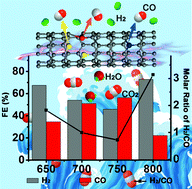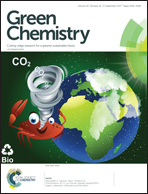Composition-tunable synthesis of “clean” syngas via a one-step synthesis of metal-free pyridinic-N-enriched self-supported CNTs: the synergy of electrocatalyst pyrolysis temperature and potential†
Abstract
Exploring efficient and environmentally friendly ways for producing clean syngas is of great significance for realizing an artificial carbon cycle associated with clean and renewable energy. Herein, as a proof-of-concept experiment, we controllably synthesized syngas via electroreduction of CO2 using an integrated 3D electrode as the catalyst. An efficient electrode was synthesized in only one step and immediately used for electroreduction of CO2 to CO with a low overpotential. Moreover, pyridinic-N predominated in the synthesized N-CNTs, followed by graphitic-N, both of which were demonstrated to supply the active nitrogen defects for the CO2 conversion. Impressively, by tuning the pyrolysis temperature or applied potential, we were able to easily tailor the H2/CO ratio in the clean syngas products in a large range between 1 : 3 and 3 : 1. This ability to tailor the H2/CO ratio has important applications in industrial production.



 Please wait while we load your content...
Please wait while we load your content...